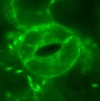








The C2H2 Zinc Finger Protein Genes of Arabidopsis thaliana
The small mustard, Arabidopsis thaliana (Brassicaceae), has become an important model system for unraveling the molecular details behind higher plant development and physiology. Arabidopsis is an ideal laboratory organism. It is small, easy to grow and produces a large number of seeds. Foreign DNA can be easily introduced into Arabidopsis by a technique known as transformation. Arabidopsis has a much smaller genome than other flowering plants and is the first higher plant for which the complete genomic DNA sequence has been completed. While Arabidopsis itself is of little agricultural importance, research in Arabidopsis has been exported into other plant systems that do have agricultural and economic importance. One additional consideration is that large numbers of researchers now use Arabidopsis, and there is widespread sharing of information and research materials.At Wake Forest, the Tague lab and the Muday lab both utilize Arabidopsis thaliana as an experimental organism. Arabidopsis has also been incorporated into a number of the undergraduate laboratory experiments.
The Tague laboratory has been working on a family of regulatory proteins from Arabidopsis known as zinc finger proteins (AtZFPs: Arabidopsis thaliana zinc finger proteins). ZFPs have been shown to play crucial regulatory roles in such developmental and morphological pathways as flower development, leaf initiation, lateral shoot initiation, gametogenesis and seed development. To understand the function of these genes in plants, our lab has taken the following types of approaches:
We ask which organs, tissues and cells of the plant express these regulatory molecules and at what times during development are they expressed? We have examined the expression pattern for AtZFP1 by a number of techniques including northern hybridization, expression of marker proteins such as ß-glucuronidase and GFP, and in situ hybridization. This work has shown that AtZFP1 is expressed in the shoot apical meristem, a key tissue of plants that gives rise to all of the above ground tissues. Additionally AtZFP1 is only expressed in the light but does not depend on active photosynthesis.
Another approach to gene and protein function is to ask what happens to the plant when one changes the expression pattern. We have constructed transgenic plants that overexpress AtZFP1 constitutively. In some transgenic lines, there is an alteration in the shape of the leaves of the plant. In other lines, with higher levels of AtZFP1 expression, there is no leaf production and the meristem appears to be ablated. The observed changes due to constitutive expression are consistent with a role for AtZFP1 in meristem function.
Currently our lab is characterizing AtZFP loss-of-function mutants, isolated in collaboration with the Arabidopsis Functional Genomics Consortium. It appears that insertion mutants in two different AtZFPs lead to a severe dwarf phenotype. These mutants are now being characterized molecularly.
Research opportunities for graduate and undergraduate students in the Tague lab include continuing projects in understanding the function of AtZFP1 and other ZFPs from Arabidopsis by using a wide range of molecular, cellular and genetic techniques.